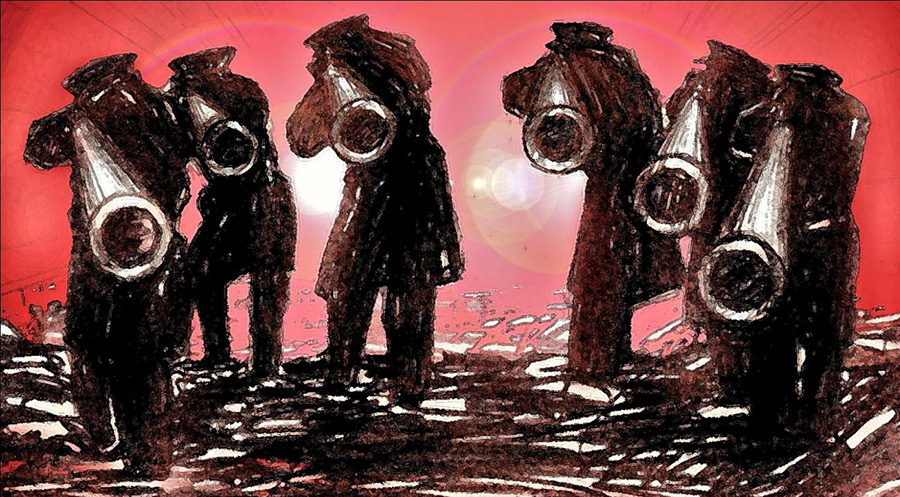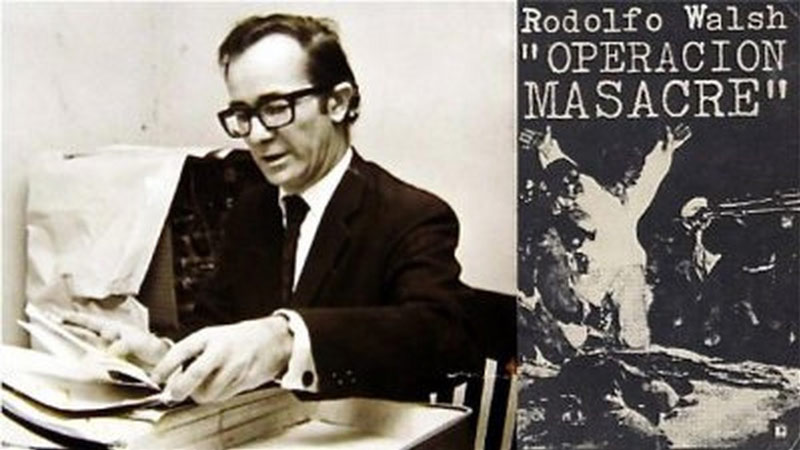
Starting the year of 1955, the tension between the Perón presidency and the Catholic Church peaked. One branch of the Argentine military that held strong faith in Catholicism threw a military coup against Perón. It was succeeded on September 16 of 1955, which this event was referred to as the Liberating Revolution (Revolución Libertadora). The military government started a process of dissolving Peronist power and his political party, and anything related to him was banned. For instance, words such as “Perón” and “Evita” were prohibited. To protect himself, Perón was exiled from Argentina until his return in 1970s. Operation Massacre is a nonfiction book written by Rodolfo Walsh that showed the Peronist militants’ resistance on June 9th of 1956 to retake power. This book was published in 1957 after the testimony of José León Suárez, which was a controversial case in the Supreme Court. Walsh started his clandestine investigation at the age of 29 as a journalist for the uprising of Peronists, but he only found 7 people who survived that night. Walsh tried to report the whole event by interviewing some survivors and participating in testimonies. This book revealed the illegal actions made by the military dictatorship government in the uprising of Peronist militants.

The book started from the night of June 9th of 1956 when all the 14 men from different backgrounds left their houses to gather with their leaders Juan José Valle and Raúl Tanco before the martial law went into effect starting the midnight of June 10th of 1956. A civil Peronist group first united in Luna Park, city of Buenos Aires with an excuse of listening to Eduardo Lausse’s fight so that they could listen to the military government’s plan there. However, this plan failed when the military government found out. The civil and military rebellion did not succeed. Many participants were arrested by the police and military. Some others escaped successfully to other countries. Juan Carlos Livarga, as one of the survivors from the military uprising, described his experience that night, as he was escaping with blood all over him in the streets while trying to save people that he did not know and those who he failed to save. Another survivor Giunta also shared his experience with Walsh by saying that the event seemed like a twist in his life like a movie, which had always been in his head. Since the opposition against the government did not succeed, “it [was] going to start from something new.” Thus, Giunta exiled himself from Argentina. For José León Suárz, his case was controversial, as there was a blind spot (punto ciego) during the transition from civil law to martial law. Before the martial law came into effect, the police had no subordination to the military, so the civil arrest by the police was not legal when the military delivered the message to them. Therefore, the judge ruled that the Buenos Aires Province police department had no rights to arrest Suárez without a trial under the civil law on the night of June 9th of 1956.
This book has a strong historical significance, as the content was presented as evidence in survivors’ testimonies. This book presented information that the news media in the past did not report, as well as more Argentines have started to know what actually happened that day in 1956. To reveal the complexity and illegal detentions from the military and the police, Walsh tried to recover original scenes vividly. At the same time, he quoted some original words from those Peronists and their families after their death and exile to provoke more emotions amongst the readers. Operation Massacre is a powerful primary source, as it showed details and memoirs of some participants and survivors in the movement. Later in 1973, the movie version of this book was in theaters in Argentina after the military dictatorship. Many footages and photos after the rebellion were also displayed on the channel “Encuentro” to support the Peronist resistance and illegality of detention and massacre. However, the wordings in describing this event varies in historiography. Contemporary left wing Argentines use this book to show the resistance to an illegitimate government in the 1950s while some others are still in favor of anti-Peronism. This book shows a controversy of his government in 20th Century Argentina and people’s divided attitudes towards Perón.
References:
Colás, Héctor Jorge. “Se cumplen 63 años del fusilamiento del general Valle”. Agencia Digital de Noticias (June 12, 2019). Accessed Feb 29 2020. https://www.adnrionegro.com.ar/2019/06/se-cumplen-63-anos-del-fusilamiento-del-general-valle/
De Santis, Carlos Alberto. “Golpe de Estado de 1955.- Fusilamientos- ley Marcial.” Revisionistas de Gral San Martín (May 26, 2014). Accessed Feb 29 2020. http://revisionistasdesanmartin.blogspot.com/2014/05/golpe-de-estado-de-1955-fusilamientos.html
Hidalgo, Manuel. “‘Operación Masacre’, el clásico de Rodolfo Walsh”. El Cultural (Sep 27, 2018). Accessed Feb 29 2020. https://elcultural.com/operacion-masacre-el-clasico-de-rodolfo-walsh.
Maferra, Julieta. “La revolución “fusiladora”y los asesinatos de la “Operación Masacre”.” Universidad (June 10, 2011). Accessed Feb 29, 2020. http://www.unidiversidad.com.ar/general-valle
Walsh, Rodolfo. Operación Masacre. Argentina: Ediciones Sigla, 1957.
Wu, Tongtong. Informe 3 in Castellano Avanzado: Cine Argentino. IFSA–Buenos Aires Global Flagship. (Nov 11, 2019). https://docs.google.com/document/d/1RB9mnuVKJbbRb0vHz2gKP2tZ4nTzoTZZPl_Ya4ZJnLA/edit
“Operación Masacre: los fusilamientos de junio de 1956.” Notas (June 9, 2014). Accessed Feb 29, 2020. https://notasperiodismopopular.com.ar/2014/06/09/operacion-masacre-los-fusilamientos-de-junio-de-1956/
“Capítulo 15. Revolución Libertadora y Resistencia Peronista” directed by Encuentro. Contributed by Geografía Historia. https://www.youtube.com/watch?v=brLqoLnBYdw. Accessed March 1, 2020.
